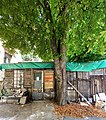Alois Rigele
Alois Rigele ( Slovak Alojz Rigele ; born February 8, 1879 in Pressburg ; † February 14, 1940 ibid) was a Slovak sculptor .
Live and act
Rigele learned sculpture from the Swiss sculptor Adolf Meszmer, a teacher for decorative sculpture . From 1901 to 1908 he studied at the Academy of Fine Arts in Vienna with Hans Bitterlich and Edmund von Hellmer at the Academy of Fine Arts . It was there that he was awarded the Füger Medal, which enabled him to go on a study trip to Italy . After three years in Rome , he moved back to Pressburg. His works, mainly executed in marble and bronze , included monuments, tombs, church sculptures, crosses and the like. a. For Emperor Franz Joseph I designed it in 1911, a statue of Queen Elizabeth . In 1914 he designed an epitaph for Bishop Péter Pázmány , which is located in St. Martin's Cathedral in Bratislava.
Rigele, who died in 1940, is buried at the Andreas cemetery , where he designed numerous tombs. He is considered to be the most important representative of the academic post-classicist line of Slovakia.
Works (selection)
- Plaque J. Fadrusz , 1903
- Drunk Roman , 1905/06
- The Return of the Prodigal Son , 1907
- Saint Elisabeth , 1907, garden of the Catholic theological faculty, Pressburg
- The dancer , 1926
- The Alchemist , around 1928, Pressburg
- Hll. Cyril and Method , 1929, Church of the Brothers of Mercy, Pressburg
- Madonna of the Seven Sorrows , 1936, Šaštín
- The woman with the deer , 1938, Pressburg
- Wall painting in the choir of the Jesuit Church, Pressburg
- War memorials for the fallen of the First World War
- Monument to Imre Madách , Dolná Strehová
- Wehrmann von Stuhlweißburg , 1914/15, pewter painted green, Heeresgeschichtliches Museum , Vienna
- Iron Honvedmann von Pressburg , 1915, tin bronzed, Heeresgeschichtliches Museum, Vienna
literature
- Ilse Krumpöck: The sculptures in the Army History Museum. Vienna 2004, p. 144 f.
- I. Chalupecký: Rigele Alois. In: Austrian Biographical Lexicon 1815–1950 (ÖBL). Volume 9, Verlag der Österreichischen Akademie der Wissenschaften, Vienna 1988, ISBN 3-7001-1483-4 , p. 160 f. (Direct links on p. 160 , p. 161 ).
- Rigele, Alois . In: Hans Vollmer (Hrsg.): General lexicon of fine artists from antiquity to the present . Founded by Ulrich Thieme and Felix Becker . tape 28 : Ramsden-Rosa . EA Seemann, Leipzig 1934, p. 352 .
- Andrej Lohnert: Alois Rigele - bratislavský sochár: 1879–1940 . Galéria Hlavného Mesta SSR, Bratislava 1977 (exhibition catalog).
- Anna Paulinyová: The Bratislava artists Robert Kühmayer and Alois Rigele . In: Karpatenblatt . May 8, 2018 ( karpatenblatt.sk ).
Web links
Individual evidence
- ↑ Ilse Krumpöck: Die Bildwerke im Heeresgeschichtliches Museum , Vienna 2004, p. 144 f.
| personal data | |
|---|---|
| SURNAME | Rigele, Alois |
| ALTERNATIVE NAMES | Rigele, Alojz |
| BRIEF DESCRIPTION | Slovak sculptor |
| DATE OF BIRTH | February 8, 1879 |
| PLACE OF BIRTH | Pressburg |
| DATE OF DEATH | February 14, 1940 |
| Place of death | Pressburg |


